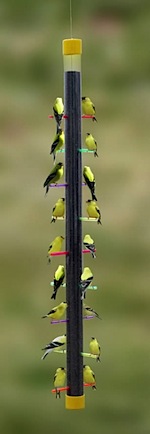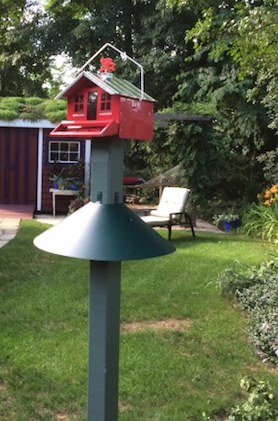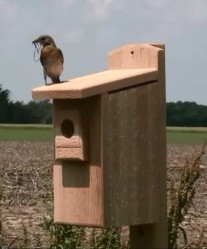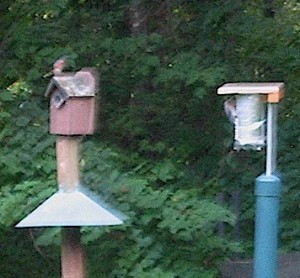-
Nyjer Feeders are Busy Now
They’re the last ones of the season to nest and raise their young, they’re also the only ones who molt twice per year. It really puts goldfinches in a class of their own. It’s the busy season for them, feeding the tiny black seed almost exclusively to babies. During the year, spells of non-activity may be common around nyjer feeders… but not now!
If you offer nyjer or thistle seed year-round, chances are great these birds will stick around. They won’t nest in a birdhouse, but prefer mature trees and shrubs for building their digs. Considered resident birds, in winter you’ll see dull brown-olive plumage, but their sweet song will still grace the garden on the dreariest days. A fresh water source will further entice these friendly fliers.
A fickle seed nyjer can be, it must be fresh for the birds to partake. Should the seed sit in your feeder too long, it may become moldy or rancid and they won’t touch it. One of the benefits of this long tube feeder is the ability to fill it from both ends. By alternating top and bottom refills, there’s no way for older seed to accumulate at the bottom like most feeders.
Another popular style is mesh or screen, offering an all-over feeding space as opposed to individual perches. In recycled plastic, some are durable enough to last a lifetime.
And the last benefit of thistle? It won’t germinate! You’ll never see a nasty weed below these feeders. So fill it up, keep seed fresh, offer a bathing spot and American goldfinches are bound to claim your garden as home sweet home!
-
Use a Squirrel Baffle to Protect that Nest!
Squirrels can be such a major nuisance around bird feeders, hence the baffle was invented. Aptly named to foil their shenanigans, lots of options are readily available to accommodate wood posts, garden poles, and hanging feeders too. Even fancy shepherd’s hooks have been taken into consideration, with a squirrel baffle that splits or opens to install – then locks back together.
With generally cooler temperatures in most parts of the country this summer, the busy nesting season has seen many birds on their second and third broods. Some use birdhouses (bluebirds, wrens, chickadees) and some don’t (cardinals, goldfinches, hummingbirds) preferring to nest in mature trees and shrubs.
Sadly, birdhouses get their share of thieves, from squirrels and raccoons, to snakes, cats and larger bully birds. Eggs and babies may be killed by territorial birds or eaten and just disappear all together.
One wouldn’t think it’s common practice to use a raccoon or squirrel baffle on a birdhouse… but until you’ve lost a nest of babies to one of these predators, it makes perfect sense!
The image at left is a bit fuzzy, but it illustrates the use of two different kinds of baffles protecting these houses. The one on the right is even home-made, using PVC pipe and an end cap from the home improvement store. It should really be at least 5 inches in diameter (this was our first try) and it works on the “rocking principle”.
A simple search for stovepipe baffle will show you how to make an expensive and effective design for posts or poles to thwart both raccoons and squirrels. Grow strong and thrive little bluebirds!





